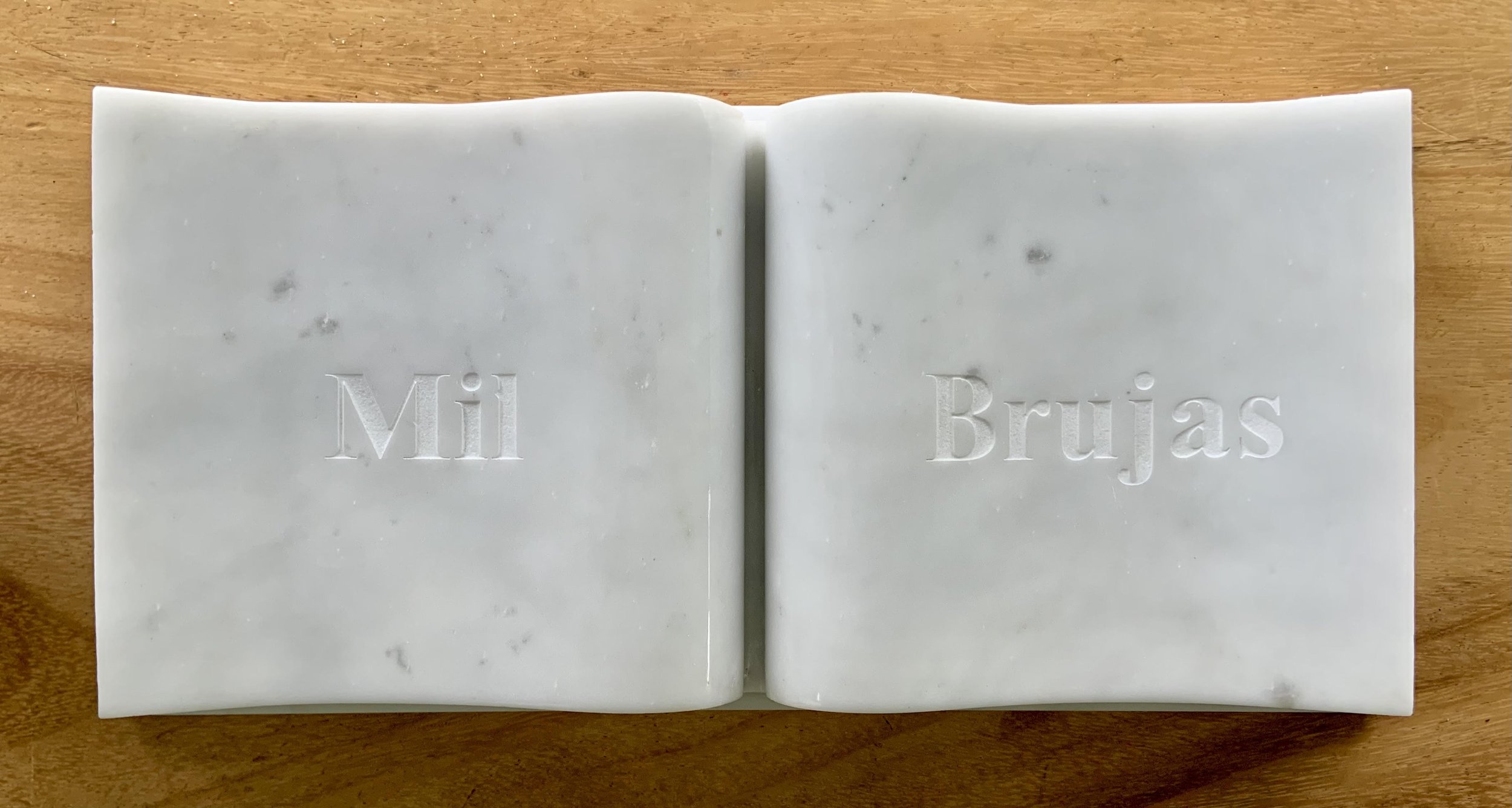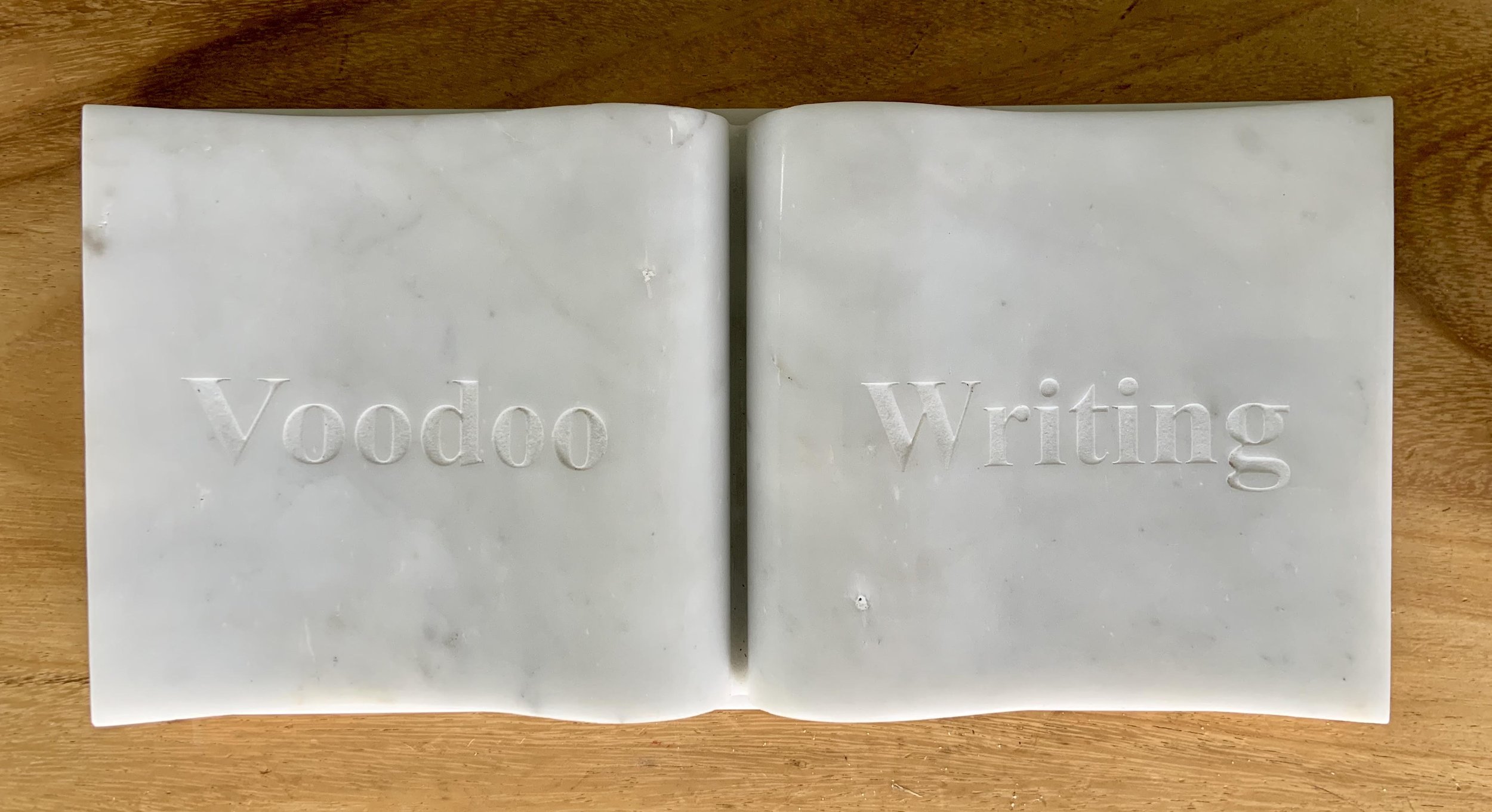Priscilla Monge
Costa Rican artist Priscilla Monge uses a range of media, including sculpture, installation, performance, and photography, to question established hierarchies and power relations. Monge’s practice allows opposites to sit uncomfortably side by side as she explores notions of love and aggression, often playing with language in the process.
In the series The Artist Reveals Mystic Truths, Monge delicately painted teacups that reveal phrases written on the inside rim in coffee, all ending in the phrase “a matter of life and death”. The blood red tablecloth, atop which the teacups are arranged, along with the muddy brown of the coffee, creates an undertone of violence that undermines the overt femininity of the teacups. Here, Monge exposes the brutality that is concealed within daily life, and the fine line that often exists between pain and pleasure.
Her series Pizarras offers a similar commentary on society’s characterization of “female hysteria”. Sentences such as “I should not have obsessive thoughts”, and “I should not cry”, are written repeatedly on chalkboards, referencing the punishment of a disobedient student as Monge makes these social taboos and prejudices visible.
Polaroid / unmentionable. In her book “Regarding the pain of others”, an essay on the documentary and iconographic representation of pain, Sontag talks about the visual representation in photography of war, violence, tragic and painful events. For her the appetite to show suffering bodies is as strong, almost, as the desire to show naked bodies. Sontag argues that perhaps the only ones with the right to look at these images of extreme pain are those who can do something to alleviate it.
For her, a photograph is like an outline, or a maxim or a proverb. Virginia Woolf in her book “The Three Guineas” tells us: “the photographs are not an argument; they are the harsh reality in front of our eyes ”.
In this period of history where there is an excess of images on the internet, in newspapers, and in magazines of all kinds, it becomes complex to talk about what can be aesthetic or not, what can be seen or not, or what that after looking for some time at loses its importance. We know that extreme violence turns people into things. They stop being subjects to become objects. In "The Disasters of War", Goya writes at the bottom of each engraving: "Feelings of what is to happen, That is why you were born, Bury and shut up, Charity, Why ?, Barbaros! This is bad, I do it saw".
Sontag tells us that all photographs are waiting to be explained or falsified by their caption or caption. We know how important this type of explanation is and how it gives truth to the image.
“Unbeatable, they are a series of enlarged Polaroid photographs, with a legend that tries to explain an image that has been completely crossed out with graphite, creating a kind of black mirror. They have to do with violence, a constant in my work. They also question that ethical part of what can or cannot be seen, what is decent, the horror that can be banalized, and the questioning that is made to the artists who work with these issues and who can fall into making the suffering of the another something aesthetic nothing more”. P. Monge
Boomerang. Priscilla Monge's works are normally minimalist in character and show us an apparent simplicity due to the use of materials; but then they introduce us to the powerful messages that each one of them represents.
Priscilla Monge's "boomerangs" originate from the concept of the return of hunting or war weapons. The boomerang is a weapon that after being thrown, if it does not hit the target, returns to its point of origin due to its aerodynamic profile. Her boomerangs are engraved with a series of insults that are thrown like a hunting weapon and are thus transformed into instruments of power and actions.
Could Monge have chosen better symbols to express the force of words with irony? The word is key in Priscilla's work and in this case she emphasizes verbal violence, totally transforming the environment.
Books. Priscilla Monge explora con minimalismo absoluto, poesía y en algunos casos casi brutalidad los estándares aplicados a la mujer, así como a la educación tradicional, la repetición y los mapas mentales de una sociedad fallida.
En Costa Rica los libros de mármol son usados como lápidas. Por ello Monge escribe en ellos a modo de epitafios. Una especio de metáfora de lo fantasmal, de lo que tiene la capacidad de regresar sea en la literatura, la educación o el arte.
Priscilla Monge explores with absolute minimalism, poetry and in some cases almost brutality the standards applied to women, as well as traditional education, repetition and the mental maps of a failed society.
In Costa Rica marble books are used as tombstones. That is why Monge writes in them as epitaphs. A kind of metaphor of the ghostly, of what has the ability to return, be it in literature, education or art.
BIO
Priscilla Monge (San José, Costa Rica, 1968)
She has participated in the Venice and Liverpool Biennales and her work has been exhibited in numerous international institutions including Museo de Arte y Diseño Contemporaneo, San José, Costa Rica; Museo Nacional Centro de Arte Reina Sofia, Madrid; MoMA PS1, New York; Brooklyn Museum, New York; Museum of Latin American Art, Los Angeles; and Museo de Arte Contemporaneo de Zulia, Venezuela, among others. Monge’s work can be found in numerous major public collections including Museo de Arte y Diseño Contemporaneo, San José, Costa Rica; Tate Modern, London; Museo Nacional Centro de Arte Reina Sofia, Madrid; and Museum of Fine Arts, Taipei.


























